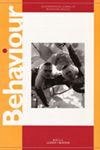Vocal behaviour reveals asymmetries in neighbour relationships in a semi-colonial raptor, the Eurasian Scops Owl Otus scops
IF 1
4区 生物学
Q4 BEHAVIORAL SCIENCES
引用次数: 1
Abstract
Territorial animals often reduce aggression towards familiar neighbours compared to unfamiliar conspecifics. However, variation in the response to different neighbours is less known. In this work, I examined the territorial behaviour of male scops owls during countersinging interactions with two familiar neighbours and I asked whether vocal behaviour of the focal male reflected dear-enemy relationships. Analysis revealed that the focal male’s vocal frequency was associated with (1) the degree of instability of the territory boundary shared with a neighbour and (2) the motivation to persist in the dyadic interaction with that neighbour. Patterns of movement directed to specific individuals suggest that scops owls do discriminate between neighbours. A case of partial territory takeover was observed that was accompanied by temporal changes in vocal frequency in one of the opponents, confirming that vocal frequency is a flexible, context-dependent feature of the relationship of neighbouring scops owls.发声行为揭示了一种半殖民地猛禽的邻居关系的不对称性,欧亚鸮
与不熟悉的同类相比,有领地意识的动物通常会减少对熟悉的邻居的攻击。然而,对不同邻居的反应差异却鲜为人知。在这项工作中,我研究了雄性猫头鹰在与两个熟悉的邻居对唱时的领土行为,并询问焦点雄性猫头鹰的声音行为是否反映了亲密的敌人关系。分析表明,焦点雄性的声音频率与(1)与邻居共享的领土边界的不稳定程度和(2)与邻居保持二元互动的动机有关。针对特定个体的运动模式表明,夜猫子确实能区分邻居。观察到一个部分领土占领的案例,伴随着其中一个对手的声音频率的时间变化,证实了声音频率是一个灵活的,依赖于相邻范围猫头鹰关系的上下文特征。
本文章由计算机程序翻译,如有差异,请以英文原文为准。
求助全文
约1分钟内获得全文
求助全文
来源期刊

Behaviour
生物-动物学
CiteScore
1.80
自引率
7.70%
发文量
44
审稿时长
3 months
期刊介绍:
Behaviour is interested in all aspects of animal (including human) behaviour, from ecology and physiology to learning, cognition, and neuroscience. Evolutionary approaches, which concern themselves with the advantages of behaviour or capacities for the organism and its reproduction, receive much attention both at a theoretical level and as it relates to specific behavior.
 求助内容:
求助内容: 应助结果提醒方式:
应助结果提醒方式:


